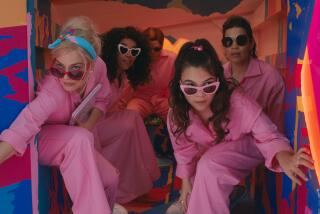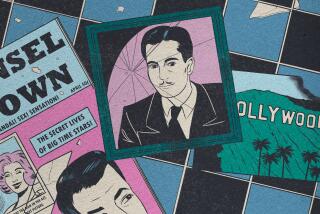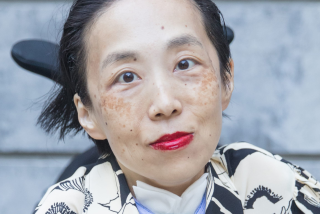In Hollywood, diversity tends to ignore the disabled
- Share via
The story at the heart of Warner Bros.’ recently released film “Me Before You” is what fairy tales are made of. An adaptation of Jojo Moyes’ 2012 book of the same name, the movie follows the relationship between a young banker (“The Hunger Games’ ” Sam Claflin) left paralyzed after an accident and his caregiver (“Game of Thrones’ ” Emilia Clarke). But to some, the choice of the able-bodied Claflin is yet another example of the film industry limiting the roles actual disabled actors get to play.
Diversity has been the talk of Hollywood, but for the most part, the conversation has centered mostly on race and gender. Some have brought in issues of sexuality, but many feel the discussion should expand to include the disabled.
“If you’re going to discuss diversity, it has to be completely inclusive of the groups that really define diversity, not just a select group that is popular,” said actor Danny Woodburn. “It’s popular to say LGBT groups, women, people of color define diversity. It’s not so popular to say people with disability define diversity. But the reality is that disability puts the ‘D’ in diversity.”
Hollywood has long received criticism over its lack of diverse representations of people in front of and behind the camera. The most recent critique came earlier this year when the film academy announced an all-white slate of acting nominees for the second year in a row. The hashtag #OscarsSoWhite, created by April Reign, immediately trended on social media. In an interview with The Times, Reign verbalized her stance on what she called “the erasure of marginalized communities” and posited a definition of diversity that included differently abled people. Most of the advocacy thus far, however, has centered on women, people of color and lesbian, gay, bisexual and transgender people.
Even when the film academy president, Cheryl Boone Isaacs, announced the organization’s commitment to diversity post-#OscarsSoWhite, only women and people of color were singled out. Additionally, The Times’ list of 100 people who could help broaden diversity in the academy — and in Hollywood — was focused on race, gender and sexuality.
To Woodburn (“Jingle All the Way,” “Seinfeld” and “Teenage Mutant Ninja Turtles”), who as a little person counts himself as a person with a disability, such an exclusion puts forth “dangerous rhetoric” that ignores a significant group of people.
According to the U.S. census, about 19% of the population identifies as differently abled -- that’s 56.7 million people. Their conditions range from intellectual disabilities such as Down syndrome to physical disabilities such as paralyzation or cerebral palsy. Others’ sensory perceptions could be affected, such as those with autism, blindness or hearing loss. A 2012 census report noted that this community has a lower likelihood of being employed and a higher likelihood of experiencing persistent poverty. As such, any diversity conversation that doesn’t make room for disabled people is “dangerous,” Woodburn said, considering the economic and policy-oriented ramifications.
One way policy is affected by such exclusion can be seen in New York, where the Writers Guild of America, East has endorsed and lobbied for modifications to the Empire State Film Production Tax Credit to include television writers and directors who are women or people of color. Woodburn, as vice chair of SAG-AFTRA’s Performers With Disabilities Committee, is working to get disability added to the potential list of supported diversity.
See the most-read stories in Entertainment this hour >>
“It’s that same separate, but equal phraseology of the 1960s, that it’s not your turn yet,” he said. “It gets my ire up. It gets me activated.”
Gail Williamson, a talent agent at Kazarian, Measures, Ruskin and Associates, has been advocating on behalf of the differently abled for more than 20 years. With 120 disabled clients on her roster, she believes a number of them could have easily taken on the “Me Before You” role.
“We refer to it as cripface, as in blackface or painting Italians to look like American Indians,” said Williamson. “We’re hoping in the future that these films would hold up more if they indeed had an actor with a disability.”
Preempting retorts that disabled people don’t have the talent, training or experience necessary to take on major roles -- a similar refrain used to justify inadequate representations of women, people of color and LGBT folk -- Williamson, whose son is an actor with Down syndrome, echoed the words of winner Viola Davis’ speech at the 2015 Primetime Emmys about just needing the opportunity.
“We’ve got them waiting, people who are trained, have done their homework and have credits, but they won’t open up the doors for them,” Williamson said. “But my guys are never going to be able to come into the room with the experience that these other guys have, because its not awarded to them. Someone is going to have to see it in them.”
Marlee Matlin, who as a deaf actress was cast as the lead in 1986’s “Children of a Lesser God,” won an Oscar and instantly became a star for the role, her first credited gig ever.
As for people the industry should be paying attention to, Williamson and other community advocates highlight Ali Stroker (Broadway’s “Spring Awakening,” “Faking It”), Jamie Brewer (“American Horror Story”), JLouis Mills (“Heartbeat,” “The Tribe”) and Robert David Hall (the “CSI” franchise), among others.
But as Adam Moore, SAG-AFTRA’s national director of equal employment opportunity and diversity, added: “Not only do they not have the opportunity for anything that is specifically written about [disabled people], but when [the story does have disabled characters] they don’t get the chance to even compete for those jobs more than half of the time.”
Moore likened the situation to casting experiences of people of color where roles are slated for whites unless otherwise stated.
“It also means nondisabled, unless otherwise labeled,” he said. “[Disabled people] are excluded almost from the beginning because stories aren’t being thought of to be told in these ways.”
Furthermore, Moore cautioned, the experience can be doubly or triply oppressive for those living at the intersections of other identities disadvantaged in the industry, such as a disabled woman of color.
But this is why disabled people need to be included in the industry’s definitions of diversity, Woodburn said. They too should be able to see themselves reflected in society’s cultural productions.
“I don’t want disabled people to be a footnote in this discussion,” he said.
Get your life! Follow me on Twitter: @TrevellAnderson.
More to Read
Only good movies
Get the Indie Focus newsletter, Mark Olsen's weekly guide to the world of cinema.
You may occasionally receive promotional content from the Los Angeles Times.










